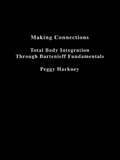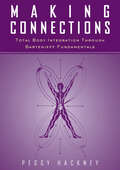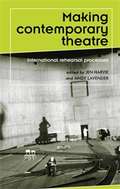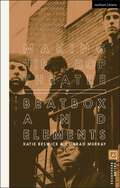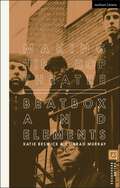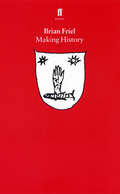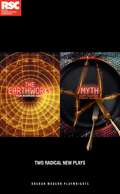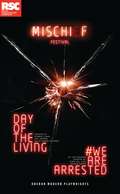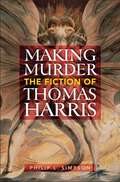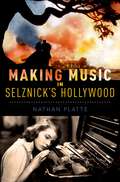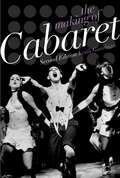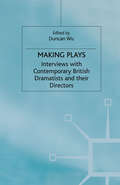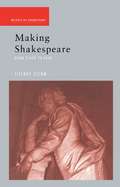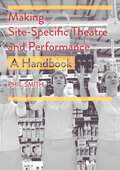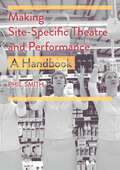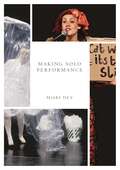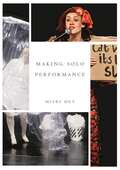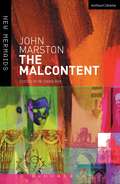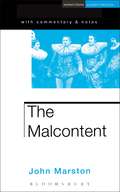- Table View
- List View
Making Connections: Total Body Integration Through Bartenieff Fundamentals
by Peggy HackneyHuman movement influences an individual's perceptions and ability to interact with the world. Through exercises, illustrations, and detailed anatomical drawings, this remarkable book guides the reader toward total body integration. An experimental approach to movement fundamentals involving the patterning of connections in the body according to principles of efficient movement, the process of total body integration encourages personal expression and full psychological involvement.
Making Connections: Total Body Integration Through Bartenieff Fundamentals
by Peggy HackneyHuman movement influences an individual's perceptions and ability to interact with the world. Through exercises, illustrations, and detailed anatomical drawings, this remarkable book guides the reader toward total body integration. An experimental approach to movement fundamentals involving the patterning of connections in the body according to principles of efficient movement, the process of total body integration encourages personal expression and full psychological involvement.
Making Connections: Total Body Integration Through Bartenieff Fundamentals
by Peggy HackneyThis book explores how we go about creating the connections within us that allow us to become fully embodied human beings in the world. It provides some very personal memories of Irmgard Bartenieff and the development of her approach to Fundamentals.
Making Connections: Total Body Integration Through Bartenieff Fundamentals
by Peggy HackneyThis book explores how we go about creating the connections within us that allow us to become fully embodied human beings in the world. It provides some very personal memories of Irmgard Bartenieff and the development of her approach to Fundamentals.
Making Contemporary Theatre: International Rehearsal Processes (PDF)
by Jen Harvie Andy LavenderMaking contemporary theatre reveals how some of the most significant international contemporary theatre is actually made. The book opens with an introductory chapter which contextualises recent trends in approaches to theatre-making. In the ensuing eleven chapters, eleven different writer-observers describe, contextualise and analyse the theatre-making practices of eleven different companies and directors, including Japan's Gekidan Kaitaisha and the Québécois director Robert Lepage. Each chapter is enriched with extensive illustrations as well as boxed-off 'asides', giving the reader different perspectives on the work. Chapters usually focus on a single production, such as Complicite's 2003-04 The Elephant Vanishes, allowing detailed investigations of complex practices to emerge. The book concludes with a brief manifesto for making contemporary theatre by the editors, plus a bibliography suggesting further reading. Making contemporary theatre is a rich resource for the theatre-making student and the theatre-goer alike, full of diverse examples of how the most exciting theatre is actually made.
Making Hip Hop Theatre: Beatbox and Elements
by Katie Beswick Conrad MurrayMaking Hip Hop Theatre is the essential, practical guide to making hip-hop theatre. It features detailed techniques and exercises that can guide creatives from workshops through to staging a performance. If you were inspired by Hamilton, Barber Shop Chronicles, Misty, Black Men Walking or Frankenstein: How to Make a Monster, this is the book for you. Covering vocal technique, use of equipment, mixing, looping, sampling, working with venues and dealing with creative challenges, this book is a bible for both new and experienced artists alike. Additionally, with links to online video material demonstrating and elaborating on the exercises included, it offers countless useful tools for teachers and facilitators of drama, music and other creative arts. Alongside this practical guidance is an overview of hip hop history, giving theoretical and historical context for the practice. From documentation of Conrad Murray's major productions, to commentary from leading practitioners including Lakeisha Lynch-Stevens, David Jubb, Emma Rice, Tobi Kyeremateng and Paula Varjack, readers are treated to a detailed insight into the background of hip hop theatre. Edited by scholar Katie Beswick and genre pioneer Conrad Murray, Making Hip Hop Theatre is a vital teaching tool and provides a much-needed account of a burgeoning aspect of contemporary theatre culture.
Making Hip Hop Theatre: Beatbox and Elements
by Katie Beswick Conrad MurrayMaking Hip Hop Theatre is the essential, practical guide to making hip-hop theatre. It features detailed techniques and exercises that can guide creatives from workshops through to staging a performance. If you were inspired by Hamilton, Barber Shop Chronicles, Misty, Black Men Walking or Frankenstein: How to Make a Monster, this is the book for you. Covering vocal technique, use of equipment, mixing, looping, sampling, working with venues and dealing with creative challenges, this book is a bible for both new and experienced artists alike. Additionally, with links to online video material demonstrating and elaborating on the exercises included, it offers countless useful tools for teachers and facilitators of drama, music and other creative arts. Alongside this practical guidance is an overview of hip hop history, giving theoretical and historical context for the practice. From documentation of Conrad Murray's major productions, to commentary from leading practitioners including Lakeisha Lynch-Stevens, David Jubb, Emma Rice, Tobi Kyeremateng and Paula Varjack, readers are treated to a detailed insight into the background of hip hop theatre. Edited by scholar Katie Beswick and genre pioneer Conrad Murray, Making Hip Hop Theatre is a vital teaching tool and provides a much-needed account of a burgeoning aspect of contemporary theatre culture.
Making History: Dancing At Lughnasa; Fathers And Sons; Making History; Wonderful Tennessee; Molly Sweeney (York Notes Advanced Ser.)
by Brian FrielThe central character of this play is Hugh O'Neill, Earl of Tyrone, who led an Irish and Spanish alliance against the armies of Elizabeth I in an attempt to drive the English out of Ireland. The action takes place before and after the Battle of Kinsale, at which the alliance was defeated: with O'Neill at home in Dungannon, as a fugitive in the mountains, and finally exiled in Rome. In his handling of this momentous episode Brian Friel has avoided the conventions of 'historical drama' to produce a play about history, the continuing process.
Making Mischief: Two Radical New Plays (Oberon Modern Playwrights)
by Tom Morton-Smith Matt Hartley Kirsty HousleyThe Earthworks by Tom Morton-Smith: ‘The universe doesn’t care if we know how it works.’ On the eve of the activation of the Large Hadron Collider, two strangers – a journalist and a scientist – share their experiences of loss and hope in a funny but deeply touching one-act play. Tom Morton-Smith’s Oppenheimer, created for the RSC in 2014, was a smash hit, transferring to the West End. Myth by Matt Hartley and Kirsty Housley From an original idea by Kirsty Housley ‘I can only see wrong choices. Things that will make everything worse.’ In one wine-fuelled evening, two couples debate their materialistic lifestyle. As their dinner party descends into chaos, their friendship and their lives are irreparably changed. A theatrical experiment into those things we don’t want to see or say. THE EARTHWORKS AND MYTH WERE PRODUCE D BY THE RSC AT THE OTHER PLACE AS PART OF THE MISCHIEF FES TIVAL IN MAY 2017.
Making Mischief: We Are Arrested; Day of the Living (Oberon Modern Playwrights)
by VariousWE ARE ARRESTED By Can Dündar Adapted by Pippa Hill and Sophie Ivatts When a journalist receives a flash-drive containing critical evidence of illegal government activity, he is duty-bound to publish the story. But with the nation destabilised and divided, a sinister power is eroding the rule of law, and he soon finds himself risking everything for his profession. We Are Arrested is the true story of a journalist’s commitment to expose the truth in the face of huge personal risks. This deeply moving play is a tribute to the bravery of journalists under threat around the globe. #WeAreArrested DAY OF THE LIVING Created by Darren Clark, Amy Draper and Juliet Gilkes Romero Ayotzinapa, Mexico, 2014. Forty-three students are forcefully disappeared. No one is brought to justice. An anarchic, musical tribute to life and the Mexican spirit with urgent, global issues at its heart. #NosFaltan43 #HastaEncontrarlos #AyotzinapaSomosTodos
Making Murder: The Fiction of Thomas Harris (Non-ser.)
by Philip L. SimpsonThomas Harris created the iconic fictional murderer and sociopath, Hannibal Lecter. This book explores and analyzes the characters, artistry, and cultural impact of Harris's novels—four of which are centered on the terrifying villain of the iconic film, The Silence of the Lambs.Making Murder takes readers deep into the work of Thomas Harris and his iconic creation, Hannibal Lecter—one of modern fiction's most unforgettable characters. A former crime reporter, Harris's exhaustive research techniques have included extensive time with the FBI's Behavioral Science Unit studying actual serial killers. Like no other available volume, the book explores the dark heart within Harris's novels—the unflinching look at evil that makes them so much more than just "good reads."Making Murder looks at all five of Harris's novels, starting with the suspenseful terrorist thriller, Black Sunday, then moving through the quartet of books in which Hannibal Lecter gradually moves from malevolent presiding spirit to unsettling, recognizably human protagonist. Author Philip Simpson looks at the critical response each book received and explores the works themselves in terms of story, characters, writing style, allusions and symbols, and themes. An introductory chapter provides insights into the author's life, publishing history, and significant cultural impact.
Making Music in Selznick's Hollywood (Oxford Music/Media Series)
by Nathan PlatteThrough the rise and fall of the Hollywood studio system, David O. Selznick reigned as Hollywood's preeminent producer. His reputation depended in large part on music. The orchestral cacophony of King Kong, the pulsing electronic sonorities of Spellbound, and the Tara theme from Gone with the Wind made music a distinguishing feature of the Selznick experience. By flaunting music's role in film and overseeing its distribution through sheet music, concerts, radio broadcasts, and soundtrack albums, Selznick cultivated a fascination with film scores. But he did not do it alone. In Making Music in Selznick's Hollywood, Nathan Platte brings to light the men and women whose work sounds throughout Selznick's many films. The cast includes familiar composers like Max Steiner, Franz Waxman, and Dimitri Tiomkin, but extends to overlooked contributors, including music editor Audray Granville, orchestrator Hugo Friedhofer, harpist Louise Klos, choral director Jester Hairston, publicist Ted Wick, and many others. Novelists, studio writers, and directors like Alfred Hitchcock also influenced the soundscapes of Selznick's films. Whether working with the producer directly or managing his presence from a distance, all had to reckon with Selznick's musical preoccupations. Rarely was it easy. Rewritten scores, fired personnel, and other skirmishes reflect the troubles-and uneven compromises-that shaped music for films like Gone with the Wind, Duel in the Sun, and Rebecca. Even Selznick anticipated that such problems would "go down in the history of Hollywood as the last wild fling of people who really fiddled-and how!-while Hollywood burned." Drawing on extensive archival research, Platte recounts those stories here, tracing Selznick's musical labors during the silent era through his work at the major studios and his culminating efforts at Selznick International Pictures. Taken together, Selznick's films provide a sweeping vista of the relationships among musicians and filmmakers that defined the Hollywood sound.
Making Music in Selznick's Hollywood (Oxford Music/Media Series)
by Nathan PlatteThrough the rise and fall of the Hollywood studio system, David O. Selznick reigned as Hollywood's preeminent producer. His reputation depended in large part on music. The orchestral cacophony of King Kong, the pulsing electronic sonorities of Spellbound, and the Tara theme from Gone with the Wind made music a distinguishing feature of the Selznick experience. By flaunting music's role in film and overseeing its distribution through sheet music, concerts, radio broadcasts, and soundtrack albums, Selznick cultivated a fascination with film scores. But he did not do it alone. In Making Music in Selznick's Hollywood, Nathan Platte brings to light the men and women whose work sounds throughout Selznick's many films. The cast includes familiar composers like Max Steiner, Franz Waxman, and Dimitri Tiomkin, but extends to overlooked contributors, including music editor Audray Granville, orchestrator Hugo Friedhofer, harpist Louise Klos, choral director Jester Hairston, publicist Ted Wick, and many others. Novelists, studio writers, and directors like Alfred Hitchcock also influenced the soundscapes of Selznick's films. Whether working with the producer directly or managing his presence from a distance, all had to reckon with Selznick's musical preoccupations. Rarely was it easy. Rewritten scores, fired personnel, and other skirmishes reflect the troubles-and uneven compromises-that shaped music for films like Gone with the Wind, Duel in the Sun, and Rebecca. Even Selznick anticipated that such problems would "go down in the history of Hollywood as the last wild fling of people who really fiddled-and how!-while Hollywood burned." Drawing on extensive archival research, Platte recounts those stories here, tracing Selznick's musical labors during the silent era through his work at the major studios and his culminating efforts at Selznick International Pictures. Taken together, Selznick's films provide a sweeping vista of the relationships among musicians and filmmakers that defined the Hollywood sound.
The Making of Cabaret
by Keith GarebianA handy and engaging chronicle, this book is the most detailed production history to date of the original Broadway version of Cabaret, showing how the show evolved from Christopher Isherwood's Berlin stories, into John van Druten's stage play, a British film adaptation, and then the Broadway musical, conceived and directed by Harold Prince as an early concept musical. With nearly 40 illustrations, full cast credits, and a bibliography, The Making of Cabaret will appeal to musical theatre aficionados, theatre specialists, and students and performers of musical theatre.
The Making of Cabaret
by Keith GarebianA handy and engaging chronicle, this book is the most detailed production history to date of the original Broadway version of Cabaret, showing how the show evolved from Christopher Isherwood's Berlin stories, into John van Druten's stage play, a British film adaptation, and then the Broadway musical, conceived and directed by Harold Prince as an early concept musical. With nearly 40 illustrations, full cast credits, and a bibliography, The Making of Cabaret will appeal to musical theatre aficionados, theatre specialists, and students and performers of musical theatre.
Making Plays: Interviews with Contemporary British Dramatists and Directors
by D. WuMaking Plays explores great drama of the last two decades through the eyes of those who write it, and those who direct it. It is at once a masterclass on theatrical technique and a unique insight into the ways in which great dramatists of our time have reacted to a rapidly changing world. In this book Duncan Wu talks to Michael Attenborough, Alan Bennett, Michael Blakemore, Howard Brenton, David Edgar, Sir Richard Eyre, Michael Frayn, Sir David Hare, Nicholas Hytner, and Max Stafford-Clark.
Making Shakespeare: From Stage to Page (Accents on Shakespeare)
by Tiffany SternMaking Shakespeare is a lively introduction to the major issues of the stage and print history, whilst also raising questions about what a Shakespeare play actually is. Tiffany Stern reveals how London, the theatre, the actors and the way in which the plays were written and printed all affect the 'Shakespeare' that we now read. Concentrating on the instability and fluidity of Shakespeare's texts, her book discusses what happened to a manuscript between its first composition, its performance on stage and its printing, and identifies traces of the production system in the plays we read. She argues that the versions of Shakespeare that have come down to us have inevitably been formed by the contexts from which they emerged; being shaped by, for example, the way actors received and responded to their lines, the props and music used in the theatre, or the continual revision of plays by the playhouses and printers. Allowing a fuller understanding of the texts we read and perform, Making Shakespeare is the perfect introduction to issues of stage and page. A refreshingly clear, accessible read, this book will allow even those with no expert knowledge to begin to contextualize Shakespeare's plays for themselves, in ways both old and new.
Making Shakespeare: From Stage to Page (Accents on Shakespeare)
by Tiffany SternMaking Shakespeare is a lively introduction to the major issues of the stage and print history, whilst also raising questions about what a Shakespeare play actually is. Tiffany Stern reveals how London, the theatre, the actors and the way in which the plays were written and printed all affect the 'Shakespeare' that we now read. Concentrating on the instability and fluidity of Shakespeare's texts, her book discusses what happened to a manuscript between its first composition, its performance on stage and its printing, and identifies traces of the production system in the plays we read. She argues that the versions of Shakespeare that have come down to us have inevitably been formed by the contexts from which they emerged; being shaped by, for example, the way actors received and responded to their lines, the props and music used in the theatre, or the continual revision of plays by the playhouses and printers. Allowing a fuller understanding of the texts we read and perform, Making Shakespeare is the perfect introduction to issues of stage and page. A refreshingly clear, accessible read, this book will allow even those with no expert knowledge to begin to contextualize Shakespeare's plays for themselves, in ways both old and new.
Making Site-Specific Theatre and Performance: A Handbook
by Phil SmithThis practical, accessible and far-reaching guide to making site-specific theatre and performance emphasises the diversity of approaches to the practice, and explores key principles of space and site. Phil Smith draws on a wide range of interdisciplinary and international performance examples, and uses an innovative variety of exercises, to show students and aspiring performance-makers how to find a site and generate a performance beyond the theatre building.
Making Site-Specific Theatre and Performance: A Handbook
by Phil SmithThis practical, accessible and far-reaching guide to making site-specific theatre and performance emphasises the diversity of approaches to the practice, and explores key principles of space and site. Phil Smith draws on a wide range of interdisciplinary and international performance examples, and uses an innovative variety of exercises, to show students and aspiring performance-makers how to find a site and generate a performance beyond the theatre building.
Making Solo Performance: Six Practitioner Interviews
by Misri DeyFocusing specifically on solo making and performing, this unique and exciting text allows the experts to speak for themselves. In interviews with Misri Dey, six recognised solo performers working across a range of performance genres – including theatre, dance, live and performance art, site-specific performance, music video and film – provide insightful and practical strategies for creative making and performing processes. Interviewees include Bryony Kimmings, Tim Etchells, Bobby Baker, Mike Pearson, Wendy Houstoun and Nigel Charnock.Engaging and accessible, this is an invaluable resource for undergraduate and postgraduate students of Theatre, Performance and Acting, scholars, lecturers and performance practitioners. It will also appeal to undergraduate and postgraduate students of Women's Studies, Creative Writing and the Visual Arts.
Making Solo Performance: Six Practitioner Interviews
by Misri DeyFocusing specifically on solo making and performing, this unique and exciting text allows the experts to speak for themselves. In interviews with Misri Dey, six recognised solo performers working across a range of performance genres – including theatre, dance, live and performance art, site-specific performance, music video and film – provide insightful and practical strategies for creative making and performing processes. Interviewees include Bryony Kimmings, Tim Etchells, Bobby Baker, Mike Pearson, Wendy Houstoun and Nigel Charnock.Engaging and accessible, this is an invaluable resource for undergraduate and postgraduate students of theatre, performance and acting, scholars, lecturers and performance practitioners. It will also appeal to undergraduate and postgraduate students of women's studies, creative writing and the visual arts.
The Malcontent (New Mermaids)
by John Marston W. David Kay"This Malevole is one of the most prodigious affections that ever conversed with nature: a man, or rather a monster, more discontent than Lucifer." The Malcontent is a striking example of the new satiric tone and moral seriousness in English comedy of the early 1600s. The play's vision of a fallen humanity driven by lust and ambition is created partly by its depiction of Machiavellian intrigue in the court of Genoa, and partly by the disaffected Malevole, the malcontent of the title, who is actually the deposed Duke Altofronto in disguise. Marston's tragi-comedy is full of reversals, surprises and moral transformations and offers a thin disguise for the Jacobean court and its vices. This new student edition contains a lengthy new Introduction with background on the author, date and sources, theme, critical interpretation and stage history.
The Malcontent (New Mermaids)
by John Marston W. David Kay"This Malevole is one of the most prodigious affections that ever conversed with nature: a man, or rather a monster, more discontent than Lucifer." The Malcontent is a striking example of the new satiric tone and moral seriousness in English comedy of the early 1600s. The play's vision of a fallen humanity driven by lust and ambition is created partly by its depiction of Machiavellian intrigue in the court of Genoa, and partly by the disaffected Malevole, the malcontent of the title, who is actually the deposed Duke Altofronto in disguise. Marston's tragi-comedy is full of reversals, surprises and moral transformations and offers a thin disguise for the Jacobean court and its vices. This new student edition contains a lengthy new Introduction with background on the author, date and sources, theme, critical interpretation and stage history.
The Malcontent (Student Editions)
by John Marston Simon Trussler William NaismithA student edition of Marston's classic playThe Malcontent is a tragicomedy deriving from the tradition of the revenge play. The verbal ingenuity of Malevole, the "malcontent", and the extravagance of the drama, push the relentlessness of intrigue to its logical conclusion, exposing the basically comic aspect of the genre. The conventional function of the climactic masque is inverted, leading to the essential resolution of the comedy.This edition comes with full commentary and notes, together with photos of Jonathan Miller's acclaimed 1973 production at the Nottingham Playhouse.
